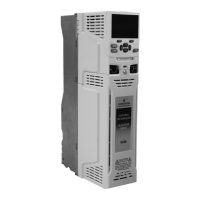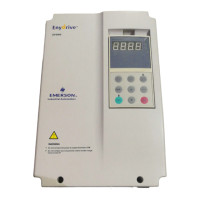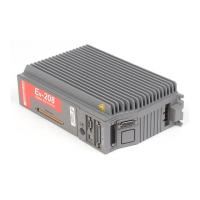Safety
information
Product
information
Mechanical
installation
Electrical
installation
Getting
started
User Menu A Commissioning
Advanced
Parameters
Diagnostics Optimization CT MODBUS RTU Technical Data
E300 Design Guide 463
Issue Number: 1
Feedback rev Encoder feedback is reversed
64
The encoder feedback is reversed with regards to the motor power connections and rotation
Recommended actions:
• Check power connections to the motor and rotation
• Motor rotation can be reversed with Reverse motor phase sequence (B26)
• Check correct connections of the encoder feedback to the drive
• Encoder feedback can be rotated with Drive Encoder Feedback Reverse (C12)
Freeze protect Freeze protection limit exceeded
60
Freeze protection threshold in Freeze Protection Threshold (H28) has been exceeded,
Recommended actions:
• Check the temperature setting in Freeze Protection Threshold (H28)
• Check the actual temperature in Monitored Temperature 3 (J73)
• Provide heating, air conditioning, ventilation to support allowable temperature in Freeze Protection Threshold (H28)
This is a delayed trip, where travel will complete (Elevator Software State (J03) = 0) and then the drive will trip. If a delayed
trip has been scheduled during travel (Elevator Software State (J03) >
0) then Global Warning (L04) = On (1) indicating
that there is a delayed trip scheduled to occur when travel completes.
I Limit Timeout Drive has been in current limit (in open-loop mode) for an excessive time
82
In Open loop mode the drive has been in current limit for Maximum Time In Current Limit (H50) ms. This could be the result
of a mechanical fault.
Recommended actions:
• Check that the elevator car is free to move.
Inductance Inductance measurement out of range or motor saturation not detected
8
The drive has been enabled in RFC-S mode and sensorless control selected, or for auto-change over on position feedback
loss, and the motor inductance will prevent the control algorithm from operating correctly. The reason for the trip can be
identified from the sub-trip number.
I/O Overload
Digital output overload
26
The I/O Overload trip indicates that the current drawn from the + 24 V user supply or from the digital output has exceeded
the limit. The trip is initiated for the following conditions:
• Maximum output current from one digital output is > 100 mA.
• The combined maximum output current from outputs 1 and 2 is > 100 mA
• The combined maximum output current from output 3 and +24 V output is > 100 mA
Recommended actions:
• Check for correct control wiring
• Check control wiring is undamaged
• Check for system fault resulting in user power supply becoming overloaded
• Check total loading on digital outputs
• Reduce loading
Trip Diagnosis
Sub-trip Reason
1
The difference between Transient Inductance Ld (B33) and No Load Lq (B37) is too small. B37 - B33 /
B33 and must be greater than 0.2. Also B37 - B33 must be greater than K / Drive Full Scale Current Kc
(J06), K is related to the drive rated voltage as given in the table below.
It is recommended that the differences are larger than the minimum limits above if possible.
2
A test is carried out to determine the direction of the flux in the motor which relies on detecting motor
saturation. If a change in motor saturation cannot be detected during this test then this trip is initiated.
This type of failure is unlikely in most normal motors.
3
During the stationary auto-tuning in RFC-S mode it is necessary to determine the location of the flux
axis. If a change in motor saturation cannot be detected during this test then this trip is initiated. This
type of failure is unlikely in most normal motors.
Drive rated voltage K
200 V 0.037
400 V 0.073
575 V 0.087
690 V 0.105

